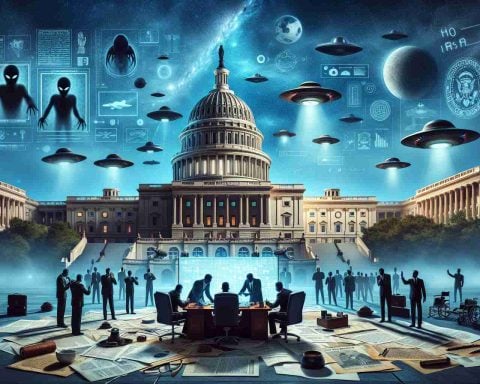- An extraordinary 2,400-page FBI archive has surfaced, unveiling secrets about major historical events and figures, including JFK’s assassination and UFO phenomena.
- President Trump declassified decades-old records regarding assassinations of JFK, Robert F. Kennedy, and Martin Luther King Jr., emphasizing governmental transparency.
- Rep. Anna Paulina Luna champions the cause, advocating for open access to the files and challenging the official narratives surrounding these high-profile cases.
- The files hint at a possible “second shooter” in JFK’s assassination, potentially reshaping public perceptions of the event.
- Uncovering Unidentified Aerial Phenomena (UAP) suggests new insights into the government’s history with UFOs, piquing public curiosity.
- The files could also implicate powerful figures linked to Jeffrey Epstein’s criminal network, promising revelations that may alter the perception of his scandal.
- This movement toward transparency could either shed light on America’s true past or deepen existing controversies.
Under a cascade of relentless curiosity, America teeters on the edge of revelation. An extraordinary 2,400-page FBI archive has surfaced, promising to unveil hidden truths and long-whispered rumors—from questions shrouding the assassination of John F. Kennedy to the murky corridors of UFO lore and the notorious entanglements of Jeffrey Epstein.
This journey toward transparency marks a pivotal shift in governmental openness. In a bold stroke, President Donald Trump mandated the declassification of decades-old, secretive records related to the assassinations of key figures such as JFK, Robert F. Kennedy, and Martin Luther King Jr. Leading this almost mythical pursuit is Florida Rep. Anna Paulina Luna, whose fierce advocacy for transparency emboldens her commitment to expunge the shadows lingering in the halls of power.
Within the crumbling pages of the uncovered files, a tantalizing theory emerges—the possibility of a “second shooter” in JFK’s assassination. Would these revelations finally sew together the tapestry of conspiracy lingering in the public consciousness, challenging the lone gunman narrative long upheld by official accounts?
Simultaneously, Luna’s emphasis on uncovering Unidentified Aerial Phenomena presents the tantalizing prospect of shaking loose the government’s tight-lipped historical engagement with UFOs since the fabled 1947 Mount Rainier “flying saucers” and the Roswell incident, opening a chapter the public hungers to read.
But the specter of Jeffrey Epstein looms darkest, with the potential exposure of influential figures caught in his intricate web of illicit activities. The promise of transparency beckons, stirring fears and hopes alike as names of the powerful may surface, rewriting the narrative of secrecy and betrayal that encased his life and death.
Will these revelations illuminate America’s past or deepen the shadows? As secrets unravel, the nation stands ready to confront its legacy, with history poised to unfold amidst suspense and anticipation.
Unlocking Secrets: What We Can Learn from the Declassified FBI Archive
How-To Steps & Life Hacks for Researchers
1. Accessing the Archive:
– Visit the official government database where declassified documents are stored. Familiarize yourself with the search tools available to efficiently find relevant documents.
2. Analyzing the Data:
– Use software tools designed to analyze large datasets. Look for patterns, consistent names, timelines, and cross-reference with existing public records.
3. Collaborating with Experts:
– Partner with historians, political analysts, and intelligence experts to gain deeper insights into complex issues such as the Kennedy assassination or UFO phenomena.
Real-World Use Cases
– Historical Research:
Academics can leverage these documents to verify long-standing theories or develop new historical interpretations based on newly uncovered evidence.
– Journalism:
Investigative journalists have the opportunity to bring new stories to light, holding entities accountable and informing the public with substantiated reports.
Market Forecasts & Industry Trends
The declassification trend indicates a future where transparency becomes a norm in governmental agencies, influencing industries such as:
– Media & Publishing:
With public interest in these uncovered truths, content based on confirmed historical narratives can reach wider audiences.
– Technology:
Development of advanced tools for data mining and analysis to assist in processing large-scale data releases.
Reviews & Comparisons
– National vs. International Perspective:
Different countries handle declassification differently. Comparing the U.S. approach to other nations can offer insights into government transparency and public engagement.
Controversies & Limitations
1. Security Concerns:
– The balance between transparency and national security remains a contentious issue. Some argue that complete openness can compromise sensitive information.
2. Incomplete Records:
– Critics highlight that redacted or missing sections of documents could skew public perception.
Features, Specs & Pricing
While accessing these archives is typically free through official government websites, ancillary tools for effective analysis may require subscriptions or licensing fees.
Security & Sustainability
– Data Integrity:
Ensure backup and data validation processes are in place when working with critical national archives to avoid misinformation.
– Sustainable Access:
Governments should maintain digital archives efficiently for future accessibility and use by the public.
Insights & Predictions
The release of the FBI archives supports a trend towards transparency which is likely to expand, with potential implications including:
– Increased trust in government operations.
– Potential policy reforms based on newly revealed information.
Tutorials & Compatibility
– Software Compatibility:
Utilizing OCR (Optical Character Recognition) tools can significantly enhance the analysis of scanned document archives.
– Tutorials:
Online courses on historical analysis and digital literacy can aid interested individuals in making the most of these documents.
Pros & Cons Overview
Pros:
– Potential to correct historical narratives.
– Encourages governmental accountability.
– Stimulates academic and public engagement.
Cons:
– Risk of spreading misinformation if not critically analyzed.
– Can lead to national security debates.
Actionable Recommendations
– Critical Review:
Always cross-reference new information with reliable sources to build an accurate understanding.
– Public Forums:
Engage in discussions and workshops to widen your perspective and interpretation of the documents.
For further reading on transparency in government data, visit the National Archives.




















